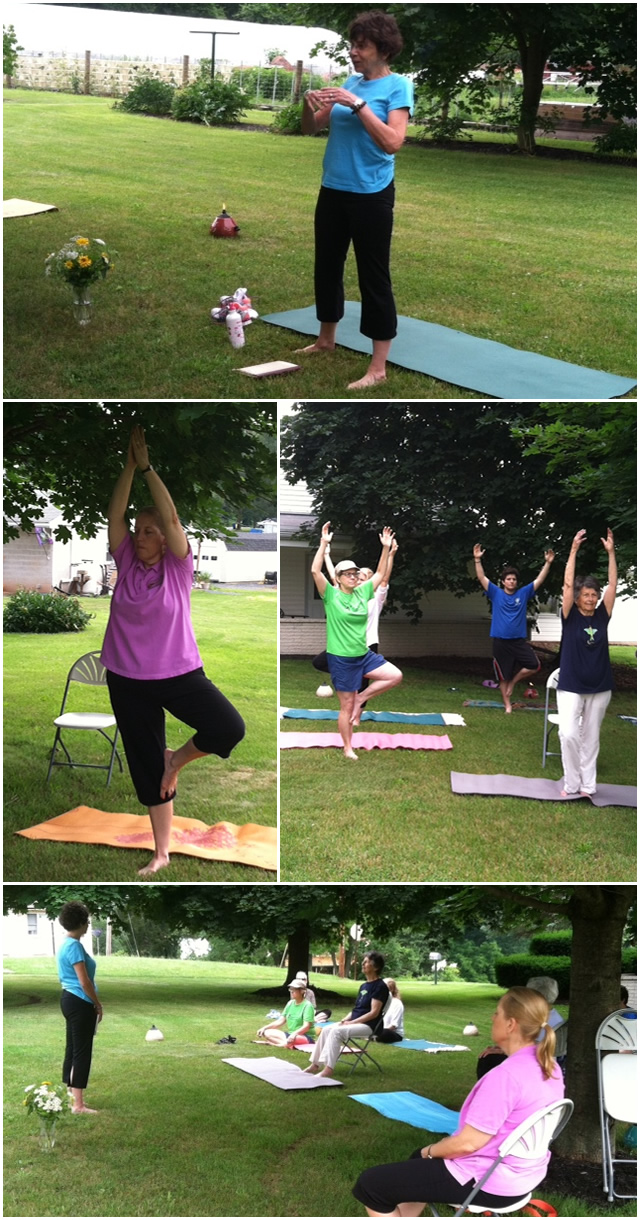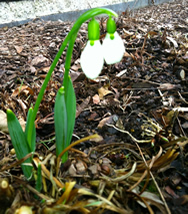Below are some images from Yoga 4 Summer Solstice class at Loaves and Fishes Farm in Dover, PA on Saturday, June 20, 2015.

Below are some images from Yoga 4 Summer Solstice class at Loaves and Fishes Farm in Dover, PA on Saturday, June 20, 2015.


This question comes up repeatedly in classes, especially when “om” is part of a mantra being chanted. Many people associate “om” with Hinduism, which can be disturbing to non-Hindus who are asked to chant “om” in a yoga class.
But there is not one simple translation for “om” or any of the other mantras in the Sanskrit language. Sanskrit, itself, has deeply ancient origins and may be the oldest language in the world. Unlike English, in which the communication of meaning is paramount, Sanskrit gives sound the highest priority. Sound carries the meaning, and meaning is in the sound. Each letter of the Sanskrit alphabet has its own energetic quality.
But what exactly is a “mantra”, you might ask. David Frawley explains in Mantra Yoga and Primal Sound, “Mantra in Sanskrit means tool ‘tra’ of the mind ‘manas.’ It is the primary tool of Yoga for calming the mind…”
Mantra has the deeper meaning of “that which protects or supports.” Often a teacher gives a student a “mantra” to help support him or her. The mantra unfolds itself to the student as it touches all parts of his or her system.
“Om” has a place in Indian mythology. As the story goes, the universe resounded with the sound and vibration of “om” at the moment of creation. Often people recognize a power in the vibrational quality of the sound as they chant it. Many experience a quieting of the mind and a calming energy when chanting “om.”
The mantra “om” comes from the sounds of “a+u+m+silence.” When chanted, the “au” or “o” has three counts, the “m” has one-half count, and then momentary silence. “Om” represents everything in creation; the silence after “om” represents that which is beyond words. Other meanings are attributed to the mantra as well. For example, “a” can represent the teacher; “u” the student; “m” their relationship. The letter “a” can stand for creation; “u” for that which sustains; “m” for dissolution. The mantra can represent the states of consciousness: “a” representing waking; “u” representing dreaming; “m,” deep sleep.
“Om” also represents a higher force. It can be the highest within you, a heart quality, love. It is a force above or beyond the mind. And, yes, when Hindus chant “Om,” it represents God.
“Om” has a mystery to it, even when we hear it without chanting ourselves. This mystery comes from the power of the vibration and sound, which is able to touch us deeply. The effect can be profound and even healing. But, let me be clear: there is no requirement in yoga to chant “om” or anything else. It is another modality to explore and to see from that exploration what might be discovered.

“Stabilizing and refining prana, our life force, is the centerpiece of yoga practice.“
…Nicolai Bachman in The Path of the Yoga Sutras
Prana is nothing less than life itself. The steady of flow of prana is necessary to support our physical, mental and emotional health. In the course of life, blocks or obstacles may develop in our system, inhibiting the movement of prana. When that happens dis-ease and illness set in. As we approach the end of life prana becomes diminished until it can no longer support life. With the last breath, prana leaves the body.
As critical as prana is to our health and our life, what can we do to support it?
The eight limbs of yoga support prana, but the tool of yoga most connected with maintaining the flow of prana is pranayama, which means “extending life force energy” or prana. When we practice pranayama we use techniques to develop a smooth, steady breath. Because the breath and mind so intimately affect one another, the smooth steady breath calms the mind, and so the body. Pranayama has the potential to remove blocks and obstacles in our system, supporting our overall well-being.
Sometimes an image comes to me that I feel compelled to share with my yoga class because it illustrates a teaching of yoga. Last week the image was a snow drop. They are small, modest, white flowers on delicate green stalks. But they can bring joy far outsized to their height and beauty as they are usually the first flowers to appear in late winter. This year, with the snow covering much of the ground, snow drops have remained hidden.
But what can a snow drop teach us about prana?
In class we began by visualizing a snow drop as the breath deepened. We stood and began to move on inhale lifting the arms and heels, and lowering them on exhale. We paused, coming back to the image of the snow drop, visualizing the first tiny shoot emerging from the bulb beneath the earth, its life force energy pushing it upward. We moved into a posture we call “triangle twist,” connecting with the shoot’s flexibility to push around obstacles and our own spine’s need for flexibility.
In honor of the life force of the snow drop and our own, we chanted a little Sanskrit chant acknowledging prana’s power and our reverence. In meditation we visualized the snow drop, its life force energy supporting its growth and blossoming.
Each day now as the snow melts, I look in my garden just outside the backdoor for the snow drops. Waiting, I think of its life force – its prana – pushing it upward through the cold earth to emerge into the light and blossom. Grateful for the life force that supports the snow drop, that sustains me and all beings, I am nourished.
You can hear the chant we used in class, honoring prana, by clicking the arrow below.
 I love designing salads. As paints are for an artist, the colors of lettuces and greens, carrots and beets, scallions and persimmons, olives and peppers, corn and peas, tomatoes and cucumbers, apples and oranges, strawberries, nuts, dates, raisins, and cranberries are my palette. I think about how their tastes and textures, as well as colors, create a beautiful, delicious, and healthful balance. But the salad is never complete until I have decided upon the perfect combination of vinegars and olive oils, enhanced with garlic, herbs, salt and pepper, to impart a glow to the greens.
I love designing salads. As paints are for an artist, the colors of lettuces and greens, carrots and beets, scallions and persimmons, olives and peppers, corn and peas, tomatoes and cucumbers, apples and oranges, strawberries, nuts, dates, raisins, and cranberries are my palette. I think about how their tastes and textures, as well as colors, create a beautiful, delicious, and healthful balance. But the salad is never complete until I have decided upon the perfect combination of vinegars and olive oils, enhanced with garlic, herbs, salt and pepper, to impart a glow to the greens.
As a painting may fall short of the painter’s intentions, my salads do not always succeed in achieving the qualities I hoped for. But the designing of a salad is still a creative act for me. I lose myself in the possibilities of combinations and how each vegetable or fruit might enhance the flavor or beauty of the others and complement the main course. My mind is so engaged in the creation of my salads, I am not aware of the passing of time, as my husband has reminded me as sits at the table waiting for me to finish.
I came across a wonderful quote in a daily meditation book. “Creative activity immerses us fully in the here and now,” the writer explains, “and at the same time it frees us. We become one with the activity and are nourished by it…We learn who we are in the very process of not thinking about who we are.” (Italics are mine.)
I was struck by how this description of creative activity also describes meditation. Patanjali, in the Yoga Sutra, explains the levels of connection between ourselves and the object of our focus, culminating in deep contemplation or samadhi. First, the senses leave their usual focus on the activities around us; this state is called pratyahara. By eliminating distractions, we can enter a state of concentration, known as dharana, as we focus on an object. As concentration becomes steady and prolonged, a deeper state or meditation, known as dhyana, may evolve in which an interplay exists between what we are focusing on and ourselves.
Returning to my example, the salad is the object. My pratyahara is the honing in on making the salad. My senses are engulfed completely by the colors, textures, smells, and tastes of my ingredients, which elicits a state of concentration or dharana. Dhyana is not only linked with what I have created physically and aesthetically, but also with the nourishment, healing and quality of health that is derived by eating it. It is almost as if the salad communicates with me, making the link more intense.
The deepest level of focus is contemplation, samadhi, in which we lose all sense of ourselves so only that object of our focus remains in our mind.
Frequently I have found many people thinking that meditation requires being seated on the floor in a lotus posture, eyes closed, sitting perfectly still and emptying the mind. Yet, you can see that while meditation requires clearing the mind of distractions, what it really requires is coming to such focus that we have a deep connection, a link, almost an integration with whatever is our chosen point of focus.